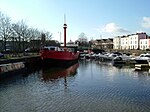Redcliffe Caves

Redcliffe Caves are a series of man made tunnels beneath the Redcliffe area of Bristol, England. The Triassic red sandstone was dug into in the Middle ages to provide sand for glass making and pottery production. Further excavation took place from the 17th to early 19th centuries and used for storage of trade goods. There is some evidence that prisoners captured during the French Revolutionary Wars or Napoleonic Wars were imprisoned in the caves but it is clear that the local folklore that slaves were imprisoned in the caves during the Bristol slave trade is false. After the closure of the last glass factory the caves were used for storage and became a rubbish dump. The caves are not generally open but have been used for film and music events. The explored and mapped area covers over 1 acre (0.40 ha) however several areas are no longer accessible and the total extent of the caves is not known.
Excerpt from the Wikipedia article Redcliffe Caves (License: CC BY-SA 3.0, Authors, Images).Redcliffe Caves
Barossa Place, Bristol Redcliffe
Geographical coordinates (GPS) Address Nearby Places Show on map
Geographical coordinates (GPS)
| Latitude | Longitude |
|---|---|
| N 51.448 ° | E -2.593 ° |
Address
Barossa Place
BS1 6SU Bristol, Redcliffe
England, United Kingdom
Open on Google Maps










